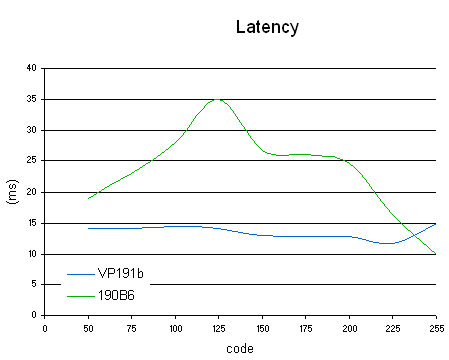Do The New 19" LCDs Pass Muster?
Latency
We measured the panel's actual latency.

Again we'll recall our test method. The curve shows the different latency values for different levels of gray. A black-white alternation is shown on the curve by a point at X-axis 255, a black-light-gray alternation produces a point at X-axis 125, a black-dark-gray alternation shows as 50, etc.
The official ISO latency rating specified by the manufacturer is only for black/white transitions (0/255). While the value we measured agrees with the manufacturer on this point, it's not of much value in judging the actual responsiveness of the panel in practice.
Unfortunately, we were disappointed. This 8 ms panel doesn't use Overdrive, and the results are immediately evident. Latency reached values we thought were already history: 35 ms on an LCD computer monitor is just too high nowadays. Compared to the results for the last generation of 12 ms panels from the LG-Philips consortium, I definitely prefer the 12 ms panel to the current one.
In Practice
We had no particular problems with office applications. Text was clear, with slightly better performance using the DVI input. Video games were playable, and even relatively enjoyable as long as the action wasn't too frenetic. On the other hand, it wasn't as nice as with the VP191b from ViewSonic, which has an Overdrive panel.
Finally, the 190B6's performance with video was very disappointing. Philips had a reputation for using noisy panels in its products, but with the 12-ms panel and the arrival of the 190X5, we had revised our judgment. With this model, Philips is back to its old tricks! The panel was VERY noisy when screening video. You can forget it for that use, especially since the viewing angles are also quite narrow.
Stay on the Cutting Edge
Join the experts who read Tom's Hardware for the inside track on enthusiast PC tech news — and have for over 25 years. We'll send breaking news and in-depth reviews of CPUs, GPUs, AI, maker hardware and more straight to your inbox.
Conclusion
We were disappointed by the 190B6, despite its new 8 ms panel. Apparently Philips hasn't yet figured out how to implement Overdrive in its 19" panels. It's true that a modicum of Overdrive can be found in the 20" panels in 16:9 format, and we'll have occasion to discuss them elsewhere. But don't forget that 95% of gamers are still using the conventional 4:3 aspect ratio.
Most Popular

